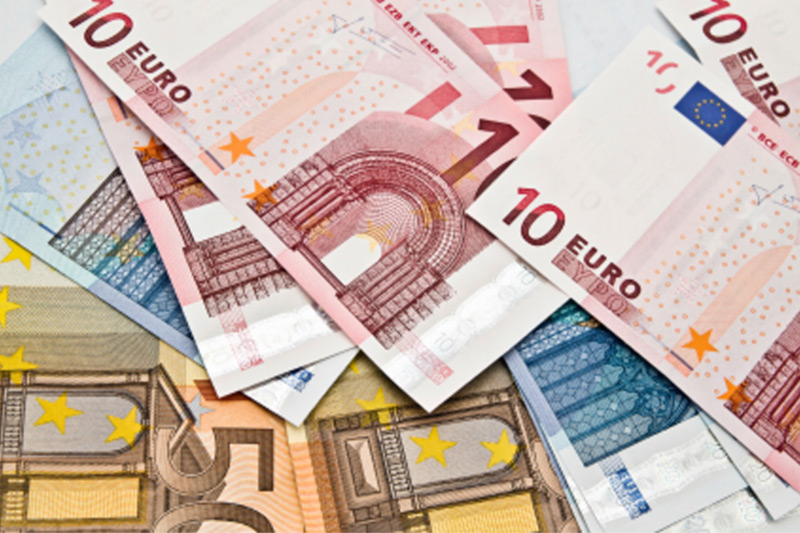Investing.com - The euro was broadly lower against its global counterparts on Thursday, after a massive liquidity injection by the European Central Bank on Wednesday, while diminished expectations for another round of easing by the Federal Reserve supported the greenback.
During European late morning trade, the euro dipped against the U.S. dollar, with EUR/USD inching down 0.02% to hit 1.3322.
Sentiment on the euro remained fragile as concerns over the effectiveness of the ECB’s long-term refinancing operation on Wednesday weighed.
Meanwhile, fears over the economic outlook for the region were exacerbated after official data showed that the unemployment rate in the single currency bloc climbed to the highest level since the inception of the euro in January, while the annualized rate of inflation also increased.
A separate report showed that the euro zone's manufacturing sector contracted for the seventh consecutive month in February.
Elsewhere, the euro was down against the pound, with EUR/GBP shedding 0.20% to hit 0.8355.
Sterling found support after data showed the manufacturing sector in the U.K. grew in February, albeit at a slightly slower-than-forecast pace, adding to hopes that the sector will fuel overall economic growth in the first quarter.
The single currency slid lower against the yen, with EUR/JPY losing 0.17% to hit 107.94.
Earlier in the day, government data showed that capital spending in Japan increased by the most in five years in the fourth quarter, adding to indications that the economy is recovering.
The euro was fractionally higher against the Swiss franc, with EUR/CHF inching up 0.02% to hit 1.2054.
In Switzerland, official data earlier showed that the economy expanded at an annualized rate of 1.3% in the in the final three months of 2011, above expectations for a 1.1% increase.
A separate report showed that manufacturing activity in Switzerland improved more-than-expected in February, but remained in contraction territory for the fifth consecutive month.
The euro was lower against the Australian, New Zealand and Canadian dollars, with EUR/AUD sliding 0.32% to hit 1.2374, EUR/NZD down 0.23% to hit 1.5935 and EUR/CAD shedding 0.37% to hit 1.3140.
The commodity linked currencies found some support earlier after government data showed that manufacturing activity in China rose more-than-expected in February, easing concerns over a hard landing in the world’s second largest economy.
Later Thursday, European Union leaders were to hold the first day of a two-day summit meeting in Brussels. Ahead of the meeting, euro zone finance misters were expected to hold talks to discuss whether Greece has fulfilled the required conditions to secure its second bailout.
Meanwhile, the U.S. was to produce government data on unemployment claims, while the Institute for Supply Management was to produce a report on manufacturing activity. In addition, Federal Reserve Chairman Ben Bernanke was due to testify for a second day before Congress.
During European late morning trade, the euro dipped against the U.S. dollar, with EUR/USD inching down 0.02% to hit 1.3322.
Sentiment on the euro remained fragile as concerns over the effectiveness of the ECB’s long-term refinancing operation on Wednesday weighed.
Meanwhile, fears over the economic outlook for the region were exacerbated after official data showed that the unemployment rate in the single currency bloc climbed to the highest level since the inception of the euro in January, while the annualized rate of inflation also increased.
A separate report showed that the euro zone's manufacturing sector contracted for the seventh consecutive month in February.
Elsewhere, the euro was down against the pound, with EUR/GBP shedding 0.20% to hit 0.8355.
Sterling found support after data showed the manufacturing sector in the U.K. grew in February, albeit at a slightly slower-than-forecast pace, adding to hopes that the sector will fuel overall economic growth in the first quarter.
The single currency slid lower against the yen, with EUR/JPY losing 0.17% to hit 107.94.
Earlier in the day, government data showed that capital spending in Japan increased by the most in five years in the fourth quarter, adding to indications that the economy is recovering.
The euro was fractionally higher against the Swiss franc, with EUR/CHF inching up 0.02% to hit 1.2054.
In Switzerland, official data earlier showed that the economy expanded at an annualized rate of 1.3% in the in the final three months of 2011, above expectations for a 1.1% increase.
A separate report showed that manufacturing activity in Switzerland improved more-than-expected in February, but remained in contraction territory for the fifth consecutive month.
The euro was lower against the Australian, New Zealand and Canadian dollars, with EUR/AUD sliding 0.32% to hit 1.2374, EUR/NZD down 0.23% to hit 1.5935 and EUR/CAD shedding 0.37% to hit 1.3140.
The commodity linked currencies found some support earlier after government data showed that manufacturing activity in China rose more-than-expected in February, easing concerns over a hard landing in the world’s second largest economy.
Later Thursday, European Union leaders were to hold the first day of a two-day summit meeting in Brussels. Ahead of the meeting, euro zone finance misters were expected to hold talks to discuss whether Greece has fulfilled the required conditions to secure its second bailout.
Meanwhile, the U.S. was to produce government data on unemployment claims, while the Institute for Supply Management was to produce a report on manufacturing activity. In addition, Federal Reserve Chairman Ben Bernanke was due to testify for a second day before Congress.
